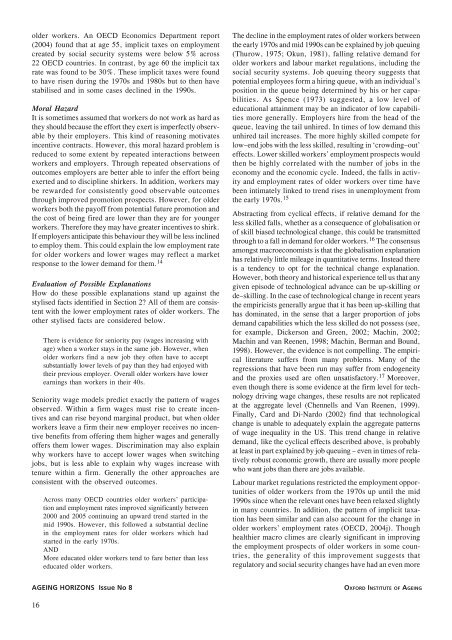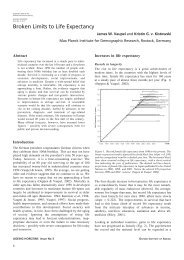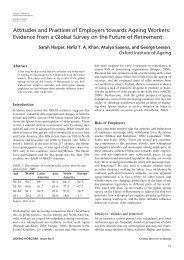Upskilling Older Workers by Ken Mayhew, Matt Elliott, and Bob Rijkers
Upskilling Older Workers by Ken Mayhew, Matt Elliott, and Bob Rijkers
Upskilling Older Workers by Ken Mayhew, Matt Elliott, and Bob Rijkers
You also want an ePaper? Increase the reach of your titles
YUMPU automatically turns print PDFs into web optimized ePapers that Google loves.
older workers. An OECD Economics Department report<br />
(2004) found that at age 55, implicit taxes on employment<br />
created <strong>by</strong> social security systems were below 5% across<br />
22 OECD countries. In contrast, <strong>by</strong> age 60 the implicit tax<br />
rate was found to be 30%. These implicit taxes were found<br />
to have risen during the 1970s <strong>and</strong> 1980s but to then have<br />
stabilised <strong>and</strong> in some cases declined in the 1990s.<br />
Moral Hazard<br />
It is sometimes assumed that workers do not work as hard as<br />
they should because the effort they exert is imperfectly observable<br />
<strong>by</strong> their employers. This kind of reasoning motivates<br />
incentive contracts. However, this moral hazard problem is<br />
reduced to some extent <strong>by</strong> repeated interactions between<br />
workers <strong>and</strong> employers. Through repeated observations of<br />
outcomes employers are better able to infer the effort being<br />
exerted <strong>and</strong> to discipline shirkers. In addition, workers may<br />
be rewarded for consistently good observable outcomes<br />
through improved promotion prospects. However, for older<br />
workers both the payoff from potential future promotion <strong>and</strong><br />
the cost of being fired are lower than they are for younger<br />
workers. Therefore they may have greater incentives to shirk.<br />
If employers anticipate this behaviour they will be less inclined<br />
to employ them. This could explain the low employment rate<br />
for older workers <strong>and</strong> lower wages may reflect a market<br />
response to the lower dem<strong>and</strong> for them. 14<br />
Evaluation of Possible Explanations<br />
How do these possible explanations st<strong>and</strong> up against the<br />
stylised facts identified in Section 2? All of them are consistent<br />
with the lower employment rates of older workers. The<br />
other stylised facts are considered below.<br />
There is evidence for seniority pay (wages increasing with<br />
age) when a worker stays in the same job. However, when<br />
older workers find a new job they often have to accept<br />
substantially lower levels of pay than they had enjoyed with<br />
their previous employer. Overall older workers have lower<br />
earnings than workers in their 40s.<br />
Seniority wage models predict exactly the pattern of wages<br />
observed. Within a firm wages must rise to create incentives<br />
<strong>and</strong> can rise beyond marginal product, but when older<br />
workers leave a firm their new employer receives no incentive<br />
benefits from offering them higher wages <strong>and</strong> generally<br />
offers them lower wages. Discrimination may also explain<br />
why workers have to accept lower wages when switching<br />
jobs, but is less able to explain why wages increase with<br />
tenure within a firm. Generally the other approaches are<br />
consistent with the observed outcomes.<br />
Across many OECD countries older workers’ participation<br />
<strong>and</strong> employment rates improved significantly between<br />
2000 <strong>and</strong> 2005 continuing an upward trend started in the<br />
mid 1990s. However, this followed a substantial decline<br />
in the employment rates for older workers which had<br />
started in the early 1970s.<br />
AND<br />
More educated older workers tend to fare better than less<br />
educated older workers.<br />
The decline in the employment rates of older workers between<br />
the early 1970s <strong>and</strong> mid 1990s can be explained <strong>by</strong> job queuing<br />
(Thurow, 1975; Okun, 1981), falling relative dem<strong>and</strong> for<br />
older workers <strong>and</strong> labour market regulations, including the<br />
social security systems. Job queuing theory suggests that<br />
potential employees form a hiring queue, with an individual’s<br />
position in the queue being determined <strong>by</strong> his or her capabilities.<br />
As Spence (1973) suggested, a low level of<br />
educational attainment may be an indicator of low capabilities<br />
more generally. Employers hire from the head of the<br />
queue, leaving the tail unhired. In times of low dem<strong>and</strong> this<br />
unhired tail increases. The more highly skilled compete for<br />
low–end jobs with the less skilled, resulting in ‘crowding–out’<br />
effects. Lower skilled workers’ employment prospects would<br />
then be highly correlated with the number of jobs in the<br />
economy <strong>and</strong> the economic cycle. Indeed, the falls in activity<br />
<strong>and</strong> employment rates of older workers over time have<br />
been intimately linked to trend rises in unemployment from<br />
the early 1970s. 15<br />
Abstracting from cyclical effects, if relative dem<strong>and</strong> for the<br />
less skilled falls, whether as a consequence of globalisation or<br />
of skill biased technological change, this could be transmitted<br />
through to a fall in dem<strong>and</strong> for older workers. 16 The consensus<br />
amongst macroeconomists is that the globalisation explanation<br />
has relatively little mileage in quantitative terms. Instead there<br />
is a tendency to opt for the technical change explanation.<br />
However, both theory <strong>and</strong> historical experience tell us that any<br />
given episode of technological advance can be up-skilling or<br />
de–skilling. In the case of technological change in recent years<br />
the empiricists generally argue that it has been up-skilling that<br />
has dominated, in the sense that a larger proportion of jobs<br />
dem<strong>and</strong> capabilities which the less skilled do not possess (see,<br />
for example, Dickerson <strong>and</strong> Green, 2002; Machin, 2002;<br />
Machin <strong>and</strong> van Reenen, 1998; Machin, Berman <strong>and</strong> Bound,<br />
1998). However, the evidence is not compelling. The empirical<br />
literature suffers from many problems. Many of the<br />
regressions that have been run may suffer from endogeneity<br />
<strong>and</strong> the proxies used are often unsatisfactory. 17 Moreover,<br />
even though there is some evidence at the firm level for technology<br />
driving wage changes, these results are not replicated<br />
at the aggregate level (Chennells <strong>and</strong> Van Reenen, 1999).<br />
Finally, Card <strong>and</strong> Di-Nardo (2002) find that technological<br />
change is unable to adequately explain the aggregate patterns<br />
of wage inequality in the US. This trend change in relative<br />
dem<strong>and</strong>, like the cyclical effects described above, is probably<br />
at least in part explained <strong>by</strong> job queuing – even in times of relatively<br />
robust economic growth, there are usually more people<br />
who want jobs than there are jobs available.<br />
Labour market regulations restricted the employment opportunities<br />
of older workers from the 1970s up until the mid<br />
1990s since when the relevant ones have been relaxed slightly<br />
in many countries. In addition, the pattern of implicit taxation<br />
has been similar <strong>and</strong> can also account for the change in<br />
older workers’ employment rates (OECD, 2004j). Though<br />
healthier macro climes are clearly significant in improving<br />
the employment prospects of older workers in some countries,<br />
the generality of this improvement suggests that<br />
regulatory <strong>and</strong> social security changes have had an even more<br />
AGEING HORIZONS Issue No 8<br />
OXFORD INSTITUTE OF AGEING<br />
16





![ORAL PRESENTATIONS [pdf] - Oxford Institute of Ageing](https://img.yumpu.com/37918222/1/184x260/oral-presentations-pdf-oxford-institute-of-ageing.jpg?quality=85)




